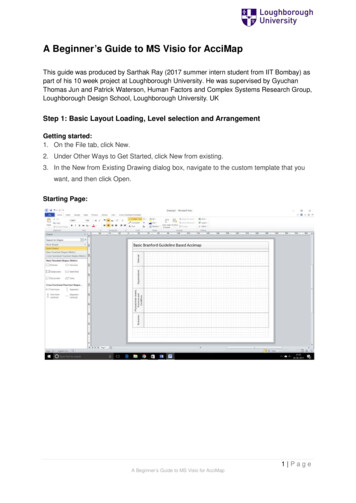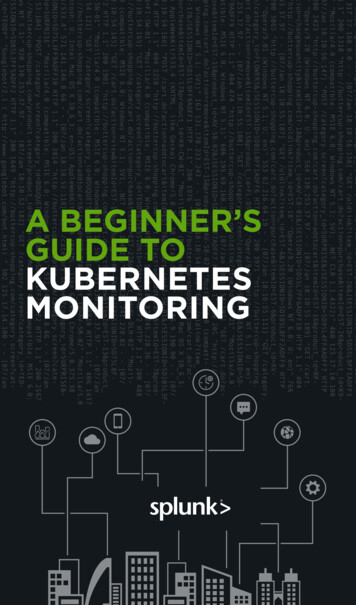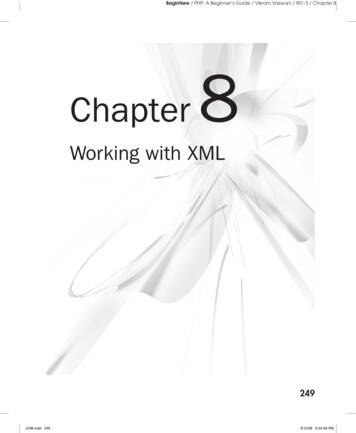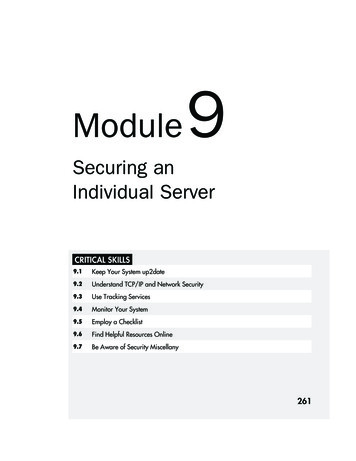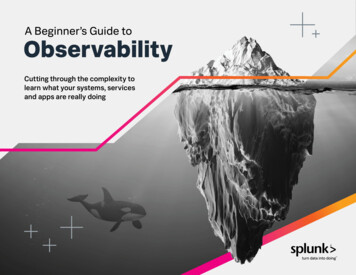
Transcription
A Beginner’s Guide toObservabilityCutting through the complexity tolearn what your systems, servicesand apps are really doing
Observability has been called everythingfrom a trendy tech buzzword to a“monitoring-on-steroids” must-have. Thetruth is more involved — especially giventhe increased complexity of moderninfrastructure and the undisputed need forbetter monitoring everywhere in the stack.Microservices, containerization, serverless —all accelerate development velocity andprovide important business benefits, but alsomultiply complexity and decrease visibility.A simple three-tier service in the old days may now be run by as many as 50microservices deployed to multiple cloud providers. Some “microservices”may actually be calls to serverless functions. This makes observing your entireapplication far more difficult.Additionally, teams requiring operational visibility have expanded beyondsysadmins and ITOps analysts. With modern DevOps models, developers aretaking greater ownership of knowing what’s going on for a better customerexperience. To effectively do this, all roles need visibility inside their entirearchitecture — from infrastructure through applications all the way out tothird-party APIs — to fix (and ideally to prevent) problems.Observability goes beyond mere monitoring (even of very complicatedinfrastructures) and is instead about building visibility into every layer of yourbusiness. Increased visibility gives everyone invested in the business greaterinsight into issues and user experience, and creates more time for morestrategic initiatives, instead of firefighting issues. It’s also critical to the overallsuccess of site reliability engineering (SRE) or DevOps organization models.In modern DevOps development processes, developers need visibility intooperational performance as much as traditional ops teams or SREs.In this guide, we’ll define what observability is and what it takes to achieve it.We’ll also give some examples of observability in action and guidance for whatto look for in a solution to help your organization achieve observability.A Beginner’s Guide to Observability Splunk2
Table of ContentsCHAPTER 1Observability — What It Is and Isn’t. 5CHAPTER 2Roadmap to Observability. 8CHAPTER 3Observability in Action . 15CHAPTER 4Options in Observability.23
Visibility Feedback Metrics InstrumentationException Tracking Controllability EventsOperational Intelligence Monitoring LogsExternalized vability PerformanceComplexityA Beginner’s Guide to Observability Splunk4
CHAPTER 1Observability — WhatIt Is and Isn’tINTRODUCTIONBuilding in FeedbackSimply defined, observability is the ability to answer any question aboutyour business or application, at any time, no matter how complex yourinfrastructure. How you do this in the application development and operationscontext is simple — by instrumenting systems and applications to collectmetrics, traces and logs, and sending all of this data to a system that can storeand analyze it and help you gain insights.Foundational to observability is building apps with the idea that someoneis going to watch them. The classic definition of observability comes fromsystem control theory, where observability is a measure of how well theinternal states of a system can be inferred from knowledge of its externaloutputs — a kind of digital exhaust. Think of it as a property of a system —another attribute, like functionality, performance or testability. You could alsothink of it as a mindset permeating design decisions: Does my system have theright instrumentation to help me answer questions about its performance?“Observability is about getting answers toquestions that we didn’t know we’d haveto ask. When I think about observability,I’m thinking from top down and bottom up.It’s the actionable insights you collect fromyour entire system, not just one piece, thattells you the health of your environment.”— Brent Miller, Senior Director of Cloud Operations, Quantum MetricA Beginner’s Guide to Observability Splunk5
Monitoring vs. ObservabilityObservabilityAll possible permutations of full and partial failureMonitoringTells you whether thesystem worksObservabilityLets you ask why it’s not workingThe collection of metrics and logsThe useful insights gainedfrom a systemfrom that dataFailure-centricIs “the how” / something you doI monitor youAbout overall behaviorof the systemIs “the process” / somethingTestingBest effortverification ofcorrectnessBest effortsimulation offailure modesMonitoringPredictablefailuresyou haveYou make yourself observableA Beginner’s Guide to Observability Splunk6
Observability as a mindsetMonitoring is something necessary, but not sufficient, to create observability.To develop effective monitors, you’re likely developing an observabilitymindset already. What’s important to note is that there’s no one particulartool that will magically give you observability — observability is a mindset,not an outcome.Observability as a mindset is the degree to which a team or company valuesthe ability to inspect and understand systems, their workload and theirbehavior. Observability moves beyond looking at the monitors for every singlecomponent of the system and looks at the outcomes of the system as a whole.Benefits of observability Comprehensive understanding of complex systems Smarter planning for code releases and application capacity Faster problem solving and shorter MTTR More insightful incident reviews Better uptime and performanceModern infrastructure has evolved from a monitoring mindset to anobservability one. In the old days, it was vital to monitor the health ofindividual services because one service was responsible for most of a user’sexperience. In modern applications, many services are used to provide theuser’s experience. If one instance of one service is having a problem, whocares, as long as the user can still do what they need to? After adopting anobservability mindset, you’re paying attention to the overall system and theuser’s experience, not each and every component of it. Observability helpsyou focus on what really matters.“Observability is not the microscope.It’s the clarity of the slide underthe microscope.”— Baron Schwartz Happier customers and more revenueA Beginner’s Guide to Observability Splunk7
CHAPTER 2Roadmap toObservabilityPillars of ObservabilityThere are three pillars that are needed for observability. More data is alwaysbetter, but without these, it will be difficult to get the benefits of observability:Logs/eventsMetricsTracesImmutable records ofdiscrete events thathappen over timeNumbers describing aparticular process oractivity measured overintervals of timeData that shows, foreach invocation of eachdownstream service,which instance was called,which method within thatinstance was invoked, howthe request performed, andwhat the results wereA Beginner’s Guide to Observability Splunk8
Modern Event-Handling TechniquesProcessing the data you’ve gathered into insights that provide observability facilitates several things,especially shared insights, collaborative response to incidents, data-supported development andintelligent operations. To get these benefits, you need a system that can do these things:Collect all dataYou need to be able to seeacross stacks, technologiesand all environments: Cloud-native (containers,cloud, serverless)Analyze andde-duplicate Separate valuablesignals from the noise Traditional (Self-hosted,on-premises, monoliths) Store statistics aboutyour data at ingest timeto get to alerts andinsights faster Support for all languagesand frameworks you use Detect outliers or otheranomalies automaticallyAdd context Show the respondingengineer what they needto fix the problem fast Minimize downtime byviewing related data toincidents with one click Determine the effectsof code deployments onkey metricsA Beginner’s Guide to Observability Splunk9
Role of AI and MLAI-driven analyticsThe volume, velocity and variety of the data needed to answer any questionabout your business is huge — and fundamentally unmanageable by humans.As buzzword-compliant as it is, to truly get to observability, sophisticatedanalytic techniques using artificial intelligence (AI) and machine learning (ML)are essential.Advances in AI can benefit you by doing the following:High-quality observability systems have learning algorithms that canunderstand the past health of your services and applications to help predictwhat’s going to happen in the future. Fully ingesting all of the data aboutyour business helps machine learning models get accurate perspectives ofhistorical and real-time data — ML helps to predict high-likelihood, potentialfuture events and harnesses the power of AI to achieve predictive intelligence. Reducing event clutter and false positives with multivariateanomaly detection Automatically concealing duplicate events to focus on relevant onesand reducing alert storms Easily sifting through vast amounts of events by filtering, taggingand sorting Enriching and adding context to events to make them informativeand actionable“A learning machine is any devicewhose actions are influenced bypast experience.”—Nils John NilssonA Beginner’s Guide to Observability Splunk10
The metrics that matterAnalysts at places including Gartner, Forrester, IDC and Computing UK haveall developed their own sets of “metrics that matter.” Based on these, thefollowing is a list of metrics and events that we’ve found to be critical forachieving full observability:MetricsEvents (Logs)Common metrics sources include: System metrics (CPU, memory, disk)Events come in three forms — plain text, structuredand binary. Common event sources include: System and server logs (syslog, journald) Infrastructure metrics (AWS CloudWatch) Web tracking scripts (Google Analytics, DigitalExperience Management) Firewall and intrusion detection system logs Application agents/collectors (APM, error tracking) Application, platform and server logs (log4j,log4net, Apache, MySQL, AWS) Business metrics (revenue, customer sign-ups,bounce rate, cart abandonment) Social media feeds (Twitter, -1TimestampMetric NameValueDimensionsSpecific parts of a user’s journey are collected intotraces, showing which services were invoked, whichcontainers/hosts/instances they were running on,and what the results of each call were.A Beginner’s Guide to Observability Splunk11
Collecting observabilityand monitoring dataExisting sourcesThe good news is that so much data exists; the challenge is aggregating andgaining insight from all of it. The following are types of data sources that haveevolved over the years — all important in achieving observability. Virtual servers: VM Logs, ESXi Logs, etc. Network flow data: router/switch counters, firewall logs, etc. Cloud services: AWS data sources such as EC2, EMR, S3, etc. Docker: logging driver, syslog, apps logs, etc. Containers and microservice architectures: container andmicroservices logs, container metrics and events, etc. Third-party services: SaaS, FaaS, serverless, etc. Control systems: vCenter, Swarm, Kubernetes, etc. Dev automation: Jenkins, Sonarcube, etc. Infra orchestration: Chef, Puppet, Ansible, etc. Signals from mobile devices: product adoption, users and clients,feature adoption, etc. Metrics for business analytics: app data, HTTP events, SFA/CRM Signals from social sentiment analytics: analyzing tweets over time Customer experience analytics: app logs, business process logs,call detail records, etc. Message buses and middlewareA Beginner’s Guide to Observability Splunk12
Cloud-native sourcesState-of-the-art OpenTelemetry: a framework that integrates with most OSS and commercialproducts to collect metrics and traces from apps written in many languagesUsed by early cloud adopters collectd: a daemon that collects metrics statsd: a daemon that listens for statistics fluentd: a daemon that unifies logdata collection Zipkin, Jaeger: Open source back-enddistributed tracing systemsThese daemonssend metrics to adefined locationvs. observability,which createsand defines themetrics thatmatter and willdrive action whenthose metrics areout of limits.It’s important to note that no code is “done” until you’ve built analytics andinstrumentation to support it. This is especially important to remember as youpursue an observability mindset.Without building in this kind of visibility, you’re unable to determine why asystem has failed, which slows response and resolution time for businesscritical issues.Proper instrumentation is vital to getting the meaningful results you’re lookingfor in an observability system in the first place. Adopting OpenTelemetrycan provide the fastest path to having instrumentation done and getting thebenefits of observability sooner.A Beginner’s Guide to Observability Splunk13
Tools needed for observabilityThere are many solutions that can help you get insights from the overwhelmingvolume of disparate data from all the sources listed above, but you’ll likelyfind that you need the following tools to answer all the questions aboutyour application, and to gain a full, end-to-end picture of it. It’s important toremember that you want the fullest fidelity possible in all of these tools:ToolInfrastructure monitoringUseDetermine the health and performance of the containers and environment yourapplications run on.Application performanceInvestigate the behavior of your application at the service level. Determine where callsmonitoringare going and how they perform.Real user monitoringSynthetic monitoringLog viewingIncident responseUnderstand the experience of real users by collecting data from browsers about howyour site performs and looks. Isolate issues to the frontend or backend.Measure the impact that releases, third-party APIs and network issues have on theperformance and reliability of your app.Dig deeper into “the why behind the what” when issues occur. Figure out how toremediate the issues quickly.Alert the right team the first time to fix the issue and provide them with the data theyneed to succeed in doing so, all in one place.A Beginner’s Guide to Observability Splunk14
CHAPTER 3Observabilityin ActionINTRODUCTIONNow that we’ve talked about whatobservability is, why it’s important, and themetrics and events it’s based on, let’s seeobservability in action.The following case studies present real customer data and results fromorganizations using Splunk’s Observability Cloud products.A Beginner’s Guide to Observability Splunk15
Application PerformanceMonitoringQuantum Metric – Rapidly-growing unicorn Quantum Metric needed a flexible observabilitysolution that collected all the data about their environment in one place. Businesses aroundthe world rely on Quantum Metric to power real-time customer insights, such as when theirapplication is experiencing errors or drops in conversion rates. Adopting Splunk ObservabilityCloud helped Quantum Metric get better understanding of their complex infrastructure andalso provided the following benefits: Better downsizing analysis and capacity planning saved over 80,000. Application development was made 96% faster, increasing developer productivity. The number of pending CI jobs was reduced by 95%. Customer-specific service level objectives (SLOs) with built-in detectors alert themimmediately when issues arise.“Observability is about getting answers to questionsthat we didn’t know we’d have to ask.”—Eric Irwin, Director of EngineeringA Beginner’s Guide to Observability Splunk16
Splunk ApplicationPerformance MonitoringFreecharge — India’s leading digital payments app was running into obstacles while tryingto migrate to a microservices-based environment. Previously, multiple monitoring tools wereneeded to get visibility into their complex application. They adopted Splunk ApplicationPerformance Monitoring and saw the following benefits: KPI monitoring helped the customer success team resolve issues with uptimeand latency 60% faster. Over a thousand compute instances were reduced to under 700, resultingin significant cost savings. The business team is alerted to issues in minutes, compared to hours with prior tools.“[Splunk Infrastructure Monitoring] monitors theheartbeat of the entire system our customersinteract with — not just our internal infrastructure,but also the external providers we’re integratedwith via API — so we can easily pinpoint andresolve issues regardless of where they are inour ecosystem.”— Sachin Sharma, Senior Director, InfrastructureA Beginner’s Guide to Observability Splunk17
Splunk InfrastructureMonitoringMark43 — Mark43’s prior infrastructure monitoring platform was unstable andnoisy, increasing workload and burying legitimate issues. After adopting SplunkInfrastructure Monitoring, Mark43 now: Is alerted to issues in seconds, compared to 10-minute latency withprevious tools. Sees improvements (which previously took a full team almost an hour)done by one engineer in minutes. Can fix issues before they have a downstream effect for the officersusing the platform.“Performance improvements thatpreviously took a full team almost an hourcan be done by one engineer in minutes.”— Kevin Heins, DevOps Technical LeadA Beginner’s Guide to Observability Splunk18
Splunk InfrastructureMonitoringAcquia — Digital-experience platform Acquia was undergoing explosivegrowth and quickly outgrew their homegrown monitoring system.Modifications took weeks, and data was missing or incomplete throughoutthe system. Reinvesting efforts into their core competency, Acquia adoptedSplunk Infrastructure Monitoring and realized these benefits, in addition togaining full observability into more than 20,000 EC2 instances: Ability to send and analyze 300 metrics with 4x more granularity than before. 1 million in annual productivity gains from 26% less time spent per incident. 600,000 annual AWS infrastructure savings. Time savings of an hour per day per technical employee.“Splunk allows us to accelerate productdevelopment, improve support efficiencyand provide business critical analytics toour customers.”— Aaron Pacheco, Product ManagerA Beginner’s Guide to Observability Splunk19
Splunk ObservabilityCloudAtlassian — Industry-leading cloud technology provider Atlassian moved froma competing product to Splunk Observability Cloud because the competingproduct couldn’t operate at Atlassian’s scale. They were encounteringslow performance, unclear billing and a lack of transparency around usage.Atlassian moved to Splunk Observability Cloud, which now supports: Delivery of 1,000 high-reliability services across 150,000 customers. A massive monitoring infrastructure that handles 1.5 million metrics/secand 1,000 dashboards and detectors. A huge team of 2,000 developers and SREs. A standard, Terraform-based approach for “observability as code.”A Beginner’s Guide to Observability Splunk20
Splunk ObservabilityCloudRappi — Number one Latin American e-commerce company Rappi’s hockeystick growth, combined with the adoption of containers and microservicesacross 6,000 hosts, strained their legacy monitoring platform, which lackedsophisticated and granular analytics, resulting in long delays to deliver alerts.After adopting Splunk Observability Cloud, Rappi: Gained real-time observability across their environment. Reduced the MTTR in production from five minutes to seconds. Accessed more complex data analytics and better metrics correlation,reducing MTTR.Grew confident in their continued migration to a microservices and serverlessarchitecture, including ECS, Kubernetes and AWS Lambda (100 services).A Beginner’s Guide to Observability Splunk21
Splunk Incident ResponsePSCU — Financial technology company PSCU knows that downtime costsmoney, and they were experiencing MTTAs of approximately four hours beforeadopting Splunk On-Call. Before using Splunk On-Call, a simple round-robinescalation process existed. After one year of using Splunk On-Call, their MTTAhad dropped an astounding 90% to 20 minutes. Further use of Splunk On-Calldropped their MTTA even further. They also saw: On-call schedules managed across departments in one tool formaximum visibility. Increased accountability for on-call teams with tracking of incidentsand their outcomes. Improved on-call experience because alerts went to the right personthe first time.“With Splunk On-Call, we took ourMTTA from four hours to two minutesand achieved stronger call-teamaccountability.”— Earl Diem, IT Operations ManagerA Beginner’s Guide to Observability Splunk22
CHAPTER 4Options inObservabilityINTRODUCTIONAs the need and demand for observabilitygrows, some monitoring tool vendors are, ofcourse, jumping on the bandwagon about asfast as they did with DevOps a while back.However, it’s important to note that no tool is going to “give you” observability.Observability is a mindset — not a practice — so any vendor promising you‘observability in a box’ should raise red flags as you research your options.Additionally, many vendors claim to have full observability capabilities, butupon closer inspection, they only offer a portion of the observability picture.If you’re going to spend the effort to adopt an observability mindset, you needto make sure that your tool can handle all of the data and provide you withreal insights.A Beginner’s Guide to Observability Splunk23
Observability Builtfor ComplexityModern development and deployment practices create increased complexity,as we’ve discussed. This complexity makes it more and more difficult to operateapplications reliably. The end goal of an observability tool should be to makeyour insights more useful and your business more effective. We recommend thatyou consider to what extent any tool you evaluate helps you do better at thesethree key operational functions:Monitorto get centralized visibility into all relevantinfrastructure and applications, no matter where orhow they are hosted. Look into containers and acrosscloud and hybrid environments. Detect root causeof issues and provide context. Generate automatedinsights to detect problems early.Collaborateacross organization silos and share the data thatmatters with every stakeholder to manage incidentresolution and build repeatable action plans. Makesure that the correct person is engaged for any alertsthe first time. Share views into issues or anomaliesthat don’t require explaining how to re-create them.Automatethe mundane, orchestrate the complex. Automateprocesses to save time to focus on what reallymatters — like strategic business initiatives — ratherthan just monitoring and troubleshooting. Eventually,orchestrate multiple processes to optimize (andminimize) human intervention in monitoring, rootcause analysis and remediation. A Beginner’s Guide to Observability Splunk24
Why You Need SplunkObservability CloudYour infrastructure and applications generate huge amounts of data everysecond. Capturing all of that data and using advanced analytic and processingtechniques helps you conquer complexity, solve problems faster, improveuser experience, and take advantage of all your data how you want to withOpenTelemetry. Splunk Observability Cloud bundles all the necessarycomponents to help you build your observability mindset: infrastructuremonitoring, application performance monitoring, real user monitoring,synthetic monitoring, log exploration and incident response.Splunk Observability Cloud’s most important benefit is helping make sense ofthe complex architecture created by modern development practices. Even ifyour organization hasn’t embraced a cloud-first solution, new developmentwill slowly move in that direction over time. Containerization, public or privatecloud hosting, serverless functions and the like all accelerate developmenttime and make innovation easier, but they also make getting a sense of what’sgoing on more difficult. Splunk Observability Cloud consolidates data acrossany hosting environment, for any application, and is the only tool that canaccept all your data, making sure you don’t miss anything.Issues happen with every system. No matter what, things will go wrong andit’s important that they can be found and fixed quickly when they do. Manyorganizations currently just perform reactive troubleshooting — they find outsomething is wrong, and then start looking through log files to find the cause.With Splunk Observability Cloud, you can see what went wrong and wherefor a particular user in a few clicks, rather than having to bounce all over yourinfrastructure trying to find the problem.Ultimately, all applications are developed to provide a service to users.Observability systems that don’t take real user experience into accountdon’t provide a full picture of what’s happening. Splunk Observability Cloudprovides a way for you to look at the actual, real-world experience any userhas by seeing exactly how long each part of your page load took and evenrecommending ways to improve that performance.Finally, instrumenting all your applications and infrastructure is a timeconsuming process. It’s the kind of thing that you need to do, but thatideally you should only do once. Splunk Observability Cloud was built forOpenTelemetry, an industry-standard instrumentation system. OpenTelemetryis the second most active Cloud Native Computing Foundation project andother open source and commercial projects are increasingly adopting it.Instrumenting your applications with OpenTelemetry means you only haveto instrument once and can then take your data to any other provider inthe future. As more projects adopt OpenTelemetry, you may even find thatnew applications come pre-instrumented and ready to emit data to SplunkObservability Cloud out of the box.A Beginner’s Guide to Observability Splunk25
Observability: Lets you conquer the complexity of modern architecture and applications and answer anyquestion about your application and business. Is a mindset, not a practice. Absorbs and extends classic monitoring systems to let you answer questions, not just hearthat something is wrong. Makes use of all your data to automatically provide insights, predict errors, and make appsbetter and users happier. Helps you solve problems in seconds, not hours. Predicts what could go wrong and helpsidentify the root cause of issues. Gives you the power to continually improve user experience by seeing snapshots of exactlywhat’s happened for each of your users. Allows you to have full control over your data and to leverage the open source community toaccelerate your observability journey.A Beginner’s Guide to Observability Splunk26
ConclusionThe hype of observability is well earned. It allows engineering teams totake greater ownership of uptime and performance, and it requires anorganizational shift to succeed. Observability cuts through the complexityof modern architecture and provides end-to-end visibility across yoursystem so you have outcomes that are quantifiable.You can quickly fix and eventually prevent problems, leaving more time forstrategic initiatives and making user experience better. The best way toachieve observability is to commit to the mindset, then adopt an approachthat gives you the power to follow any user request or incident all the waythrough your stack and beyond — from the user’s browser all the way throughto third-party APIs. When issues occur, select a tool that makes monitoring,collaborating and automating easier, ideally aided by AI and ML. Customerswho have achieved observability using Splunk have achieved a wide rangeof measurable business results, happier developers and faster resolution ofcomplicated issues.Splunk Observability Cloud is the only answer to achieving observability at fullfidelity throughout any enterprise and deployment scenario, at any scale —from megabytes to petabytes of data per day. Watch a demo.Get Started for FreeSplunk, Splunk , Data-to-Everything, D2E and Turn Data Into Doing are trademarks and registered trademarks ofSplunk Inc. in the United States and other countries. All other brand names, product names or trademarks belongto their respective owners. 2021 Splunk Inc. All rights ability-EB-110
OpenTelemetry. Splunk Observability Cloud bundles all the necessary components to help you build your observability mindset: infrastructure monitoring, application performance monitoring, real user monitoring, synthetic monitoring, log exploration and incident response. Splunk Observability Cloud's most important benefit is helping make sense of



